Marketing Research: Customer Feedback & Domino's NZ Improvement
VerifiedAdded on 2023/06/07
|22
|4608
|412
Report
AI Summary
This report presents a marketing research proposal focusing on customer feedback and its impact on Domino's New Zealand. The study aims to identify opportunities for improvement in products and services to increase market share within the competitive fast-food industry. The research employs a mixed-methods approach, utilizing both quantitative (surveys, statistical analysis) and qualitative (literature review, interpretation) methods to address research questions related to the effectiveness of customer feedback and strategies for improvement. The research design includes a deductive approach, developing a hypothesis based on existing theories. Data collection will involve customer surveys distributed via email using a Google form, with a sampling strategy employing simple random sampling from Domino's New Zealand customer base. The report outlines a detailed project timeline, data collection methods, and cost estimates, providing a comprehensive framework for the proposed research.
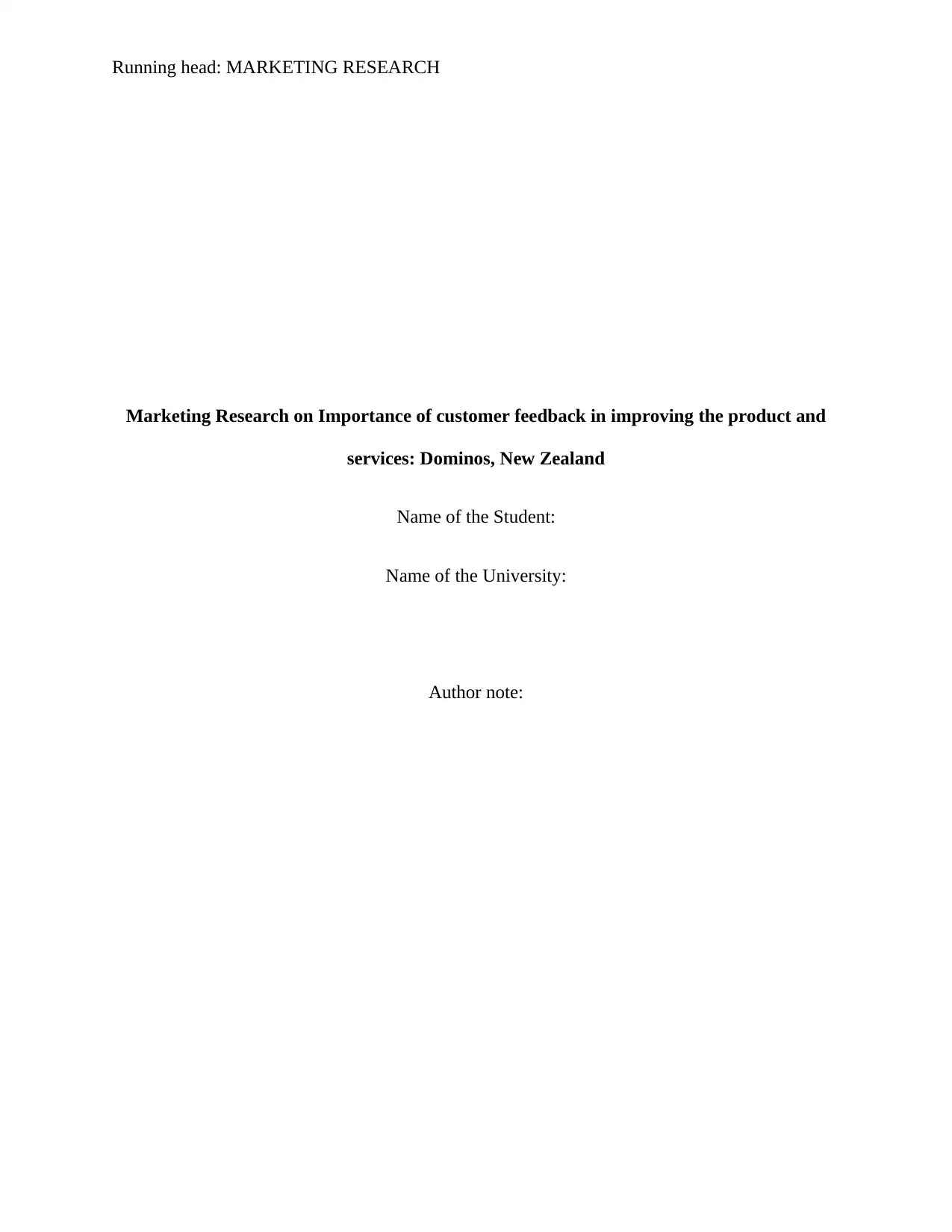
Running head: MARKETING RESEARCH
Marketing Research on Importance of customer feedback in improving the product and
services: Dominos, New Zealand
Name of the Student:
Name of the University:
Author note:
Marketing Research on Importance of customer feedback in improving the product and
services: Dominos, New Zealand
Name of the Student:
Name of the University:
Author note:
Paraphrase This Document
Need a fresh take? Get an instant paraphrase of this document with our AI Paraphraser
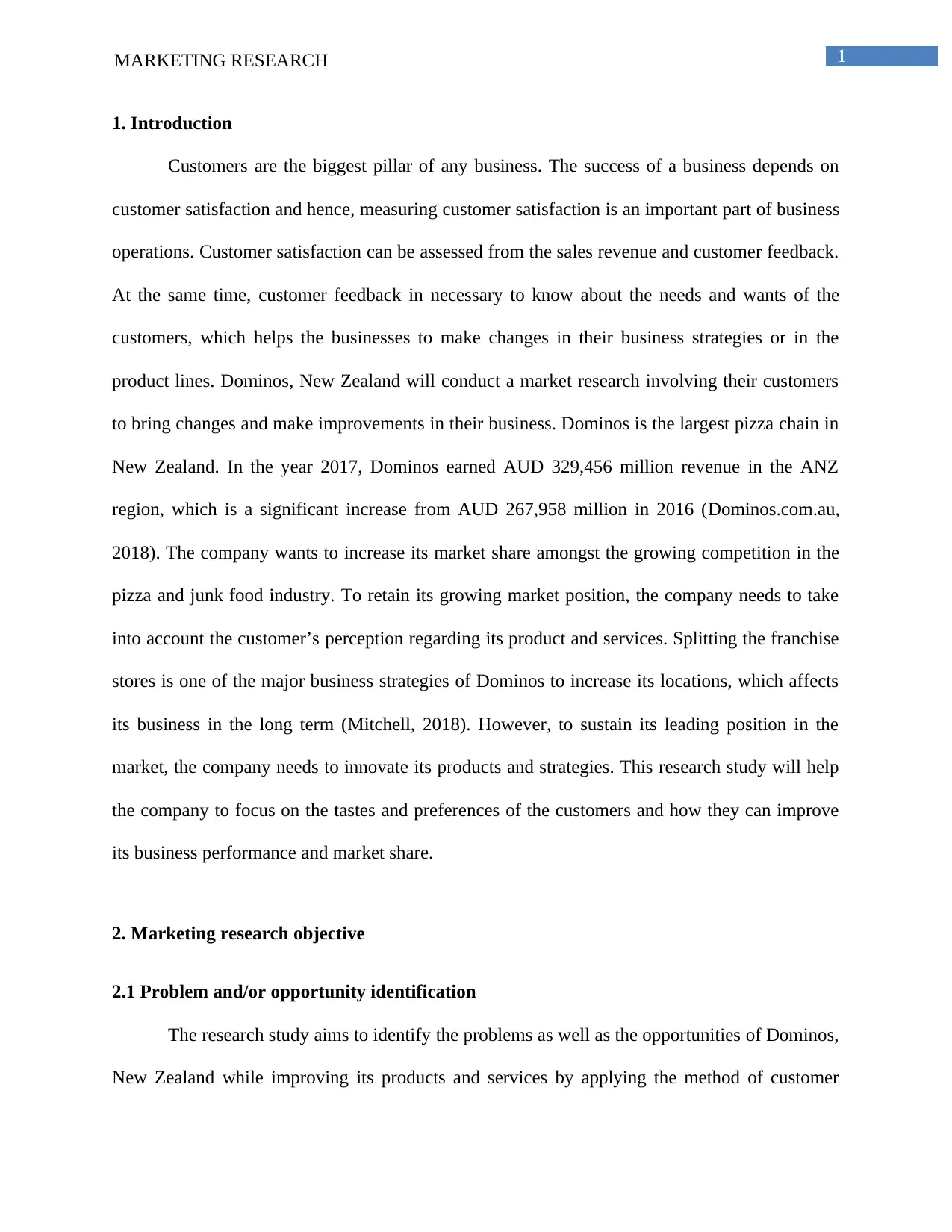
1MARKETING RESEARCH
1. Introduction
Customers are the biggest pillar of any business. The success of a business depends on
customer satisfaction and hence, measuring customer satisfaction is an important part of business
operations. Customer satisfaction can be assessed from the sales revenue and customer feedback.
At the same time, customer feedback in necessary to know about the needs and wants of the
customers, which helps the businesses to make changes in their business strategies or in the
product lines. Dominos, New Zealand will conduct a market research involving their customers
to bring changes and make improvements in their business. Dominos is the largest pizza chain in
New Zealand. In the year 2017, Dominos earned AUD 329,456 million revenue in the ANZ
region, which is a significant increase from AUD 267,958 million in 2016 (Dominos.com.au,
2018). The company wants to increase its market share amongst the growing competition in the
pizza and junk food industry. To retain its growing market position, the company needs to take
into account the customer’s perception regarding its product and services. Splitting the franchise
stores is one of the major business strategies of Dominos to increase its locations, which affects
its business in the long term (Mitchell, 2018). However, to sustain its leading position in the
market, the company needs to innovate its products and strategies. This research study will help
the company to focus on the tastes and preferences of the customers and how they can improve
its business performance and market share.
2. Marketing research objective
2.1 Problem and/or opportunity identification
The research study aims to identify the problems as well as the opportunities of Dominos,
New Zealand while improving its products and services by applying the method of customer
1. Introduction
Customers are the biggest pillar of any business. The success of a business depends on
customer satisfaction and hence, measuring customer satisfaction is an important part of business
operations. Customer satisfaction can be assessed from the sales revenue and customer feedback.
At the same time, customer feedback in necessary to know about the needs and wants of the
customers, which helps the businesses to make changes in their business strategies or in the
product lines. Dominos, New Zealand will conduct a market research involving their customers
to bring changes and make improvements in their business. Dominos is the largest pizza chain in
New Zealand. In the year 2017, Dominos earned AUD 329,456 million revenue in the ANZ
region, which is a significant increase from AUD 267,958 million in 2016 (Dominos.com.au,
2018). The company wants to increase its market share amongst the growing competition in the
pizza and junk food industry. To retain its growing market position, the company needs to take
into account the customer’s perception regarding its product and services. Splitting the franchise
stores is one of the major business strategies of Dominos to increase its locations, which affects
its business in the long term (Mitchell, 2018). However, to sustain its leading position in the
market, the company needs to innovate its products and strategies. This research study will help
the company to focus on the tastes and preferences of the customers and how they can improve
its business performance and market share.
2. Marketing research objective
2.1 Problem and/or opportunity identification
The research study aims to identify the problems as well as the opportunities of Dominos,
New Zealand while improving its products and services by applying the method of customer
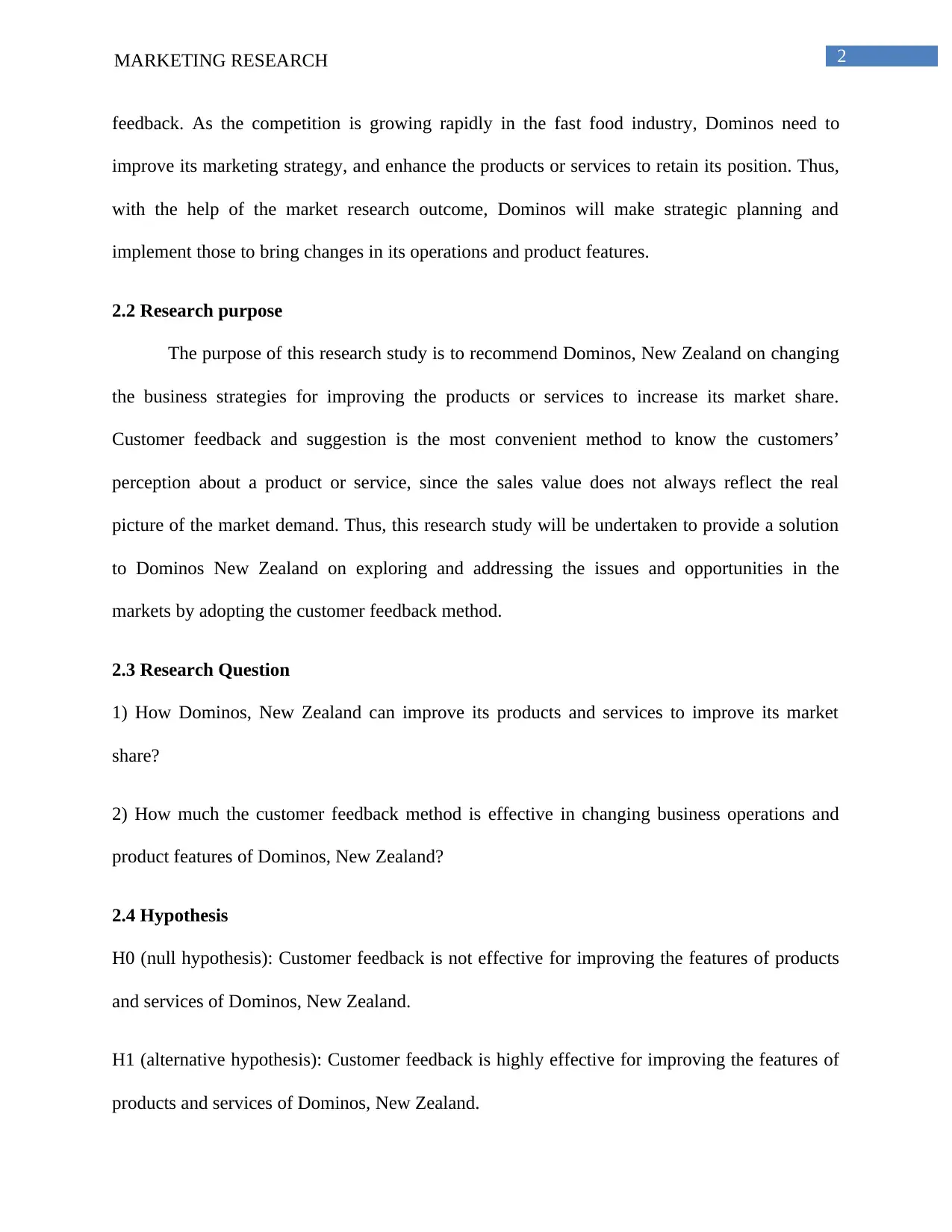
2MARKETING RESEARCH
feedback. As the competition is growing rapidly in the fast food industry, Dominos need to
improve its marketing strategy, and enhance the products or services to retain its position. Thus,
with the help of the market research outcome, Dominos will make strategic planning and
implement those to bring changes in its operations and product features.
2.2 Research purpose
The purpose of this research study is to recommend Dominos, New Zealand on changing
the business strategies for improving the products or services to increase its market share.
Customer feedback and suggestion is the most convenient method to know the customers’
perception about a product or service, since the sales value does not always reflect the real
picture of the market demand. Thus, this research study will be undertaken to provide a solution
to Dominos New Zealand on exploring and addressing the issues and opportunities in the
markets by adopting the customer feedback method.
2.3 Research Question
1) How Dominos, New Zealand can improve its products and services to improve its market
share?
2) How much the customer feedback method is effective in changing business operations and
product features of Dominos, New Zealand?
2.4 Hypothesis
H0 (null hypothesis): Customer feedback is not effective for improving the features of products
and services of Dominos, New Zealand.
H1 (alternative hypothesis): Customer feedback is highly effective for improving the features of
products and services of Dominos, New Zealand.
feedback. As the competition is growing rapidly in the fast food industry, Dominos need to
improve its marketing strategy, and enhance the products or services to retain its position. Thus,
with the help of the market research outcome, Dominos will make strategic planning and
implement those to bring changes in its operations and product features.
2.2 Research purpose
The purpose of this research study is to recommend Dominos, New Zealand on changing
the business strategies for improving the products or services to increase its market share.
Customer feedback and suggestion is the most convenient method to know the customers’
perception about a product or service, since the sales value does not always reflect the real
picture of the market demand. Thus, this research study will be undertaken to provide a solution
to Dominos New Zealand on exploring and addressing the issues and opportunities in the
markets by adopting the customer feedback method.
2.3 Research Question
1) How Dominos, New Zealand can improve its products and services to improve its market
share?
2) How much the customer feedback method is effective in changing business operations and
product features of Dominos, New Zealand?
2.4 Hypothesis
H0 (null hypothesis): Customer feedback is not effective for improving the features of products
and services of Dominos, New Zealand.
H1 (alternative hypothesis): Customer feedback is highly effective for improving the features of
products and services of Dominos, New Zealand.
⊘ This is a preview!⊘
Do you want full access?
Subscribe today to unlock all pages.

Trusted by 1+ million students worldwide
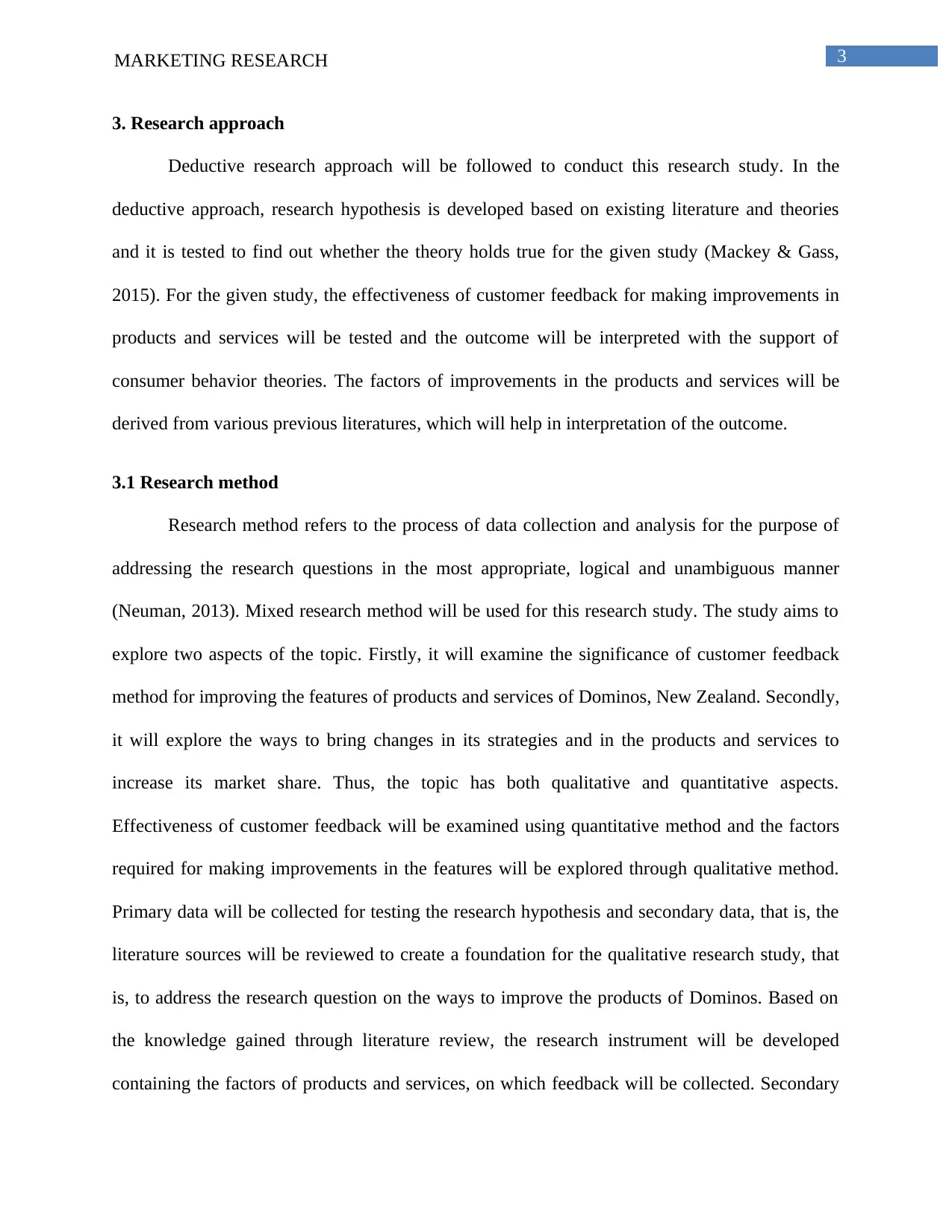
3MARKETING RESEARCH
3. Research approach
Deductive research approach will be followed to conduct this research study. In the
deductive approach, research hypothesis is developed based on existing literature and theories
and it is tested to find out whether the theory holds true for the given study (Mackey & Gass,
2015). For the given study, the effectiveness of customer feedback for making improvements in
products and services will be tested and the outcome will be interpreted with the support of
consumer behavior theories. The factors of improvements in the products and services will be
derived from various previous literatures, which will help in interpretation of the outcome.
3.1 Research method
Research method refers to the process of data collection and analysis for the purpose of
addressing the research questions in the most appropriate, logical and unambiguous manner
(Neuman, 2013). Mixed research method will be used for this research study. The study aims to
explore two aspects of the topic. Firstly, it will examine the significance of customer feedback
method for improving the features of products and services of Dominos, New Zealand. Secondly,
it will explore the ways to bring changes in its strategies and in the products and services to
increase its market share. Thus, the topic has both qualitative and quantitative aspects.
Effectiveness of customer feedback will be examined using quantitative method and the factors
required for making improvements in the features will be explored through qualitative method.
Primary data will be collected for testing the research hypothesis and secondary data, that is, the
literature sources will be reviewed to create a foundation for the qualitative research study, that
is, to address the research question on the ways to improve the products of Dominos. Based on
the knowledge gained through literature review, the research instrument will be developed
containing the factors of products and services, on which feedback will be collected. Secondary
3. Research approach
Deductive research approach will be followed to conduct this research study. In the
deductive approach, research hypothesis is developed based on existing literature and theories
and it is tested to find out whether the theory holds true for the given study (Mackey & Gass,
2015). For the given study, the effectiveness of customer feedback for making improvements in
products and services will be tested and the outcome will be interpreted with the support of
consumer behavior theories. The factors of improvements in the products and services will be
derived from various previous literatures, which will help in interpretation of the outcome.
3.1 Research method
Research method refers to the process of data collection and analysis for the purpose of
addressing the research questions in the most appropriate, logical and unambiguous manner
(Neuman, 2013). Mixed research method will be used for this research study. The study aims to
explore two aspects of the topic. Firstly, it will examine the significance of customer feedback
method for improving the features of products and services of Dominos, New Zealand. Secondly,
it will explore the ways to bring changes in its strategies and in the products and services to
increase its market share. Thus, the topic has both qualitative and quantitative aspects.
Effectiveness of customer feedback will be examined using quantitative method and the factors
required for making improvements in the features will be explored through qualitative method.
Primary data will be collected for testing the research hypothesis and secondary data, that is, the
literature sources will be reviewed to create a foundation for the qualitative research study, that
is, to address the research question on the ways to improve the products of Dominos. Based on
the knowledge gained through literature review, the research instrument will be developed
containing the factors of products and services, on which feedback will be collected. Secondary
Paraphrase This Document
Need a fresh take? Get an instant paraphrase of this document with our AI Paraphraser
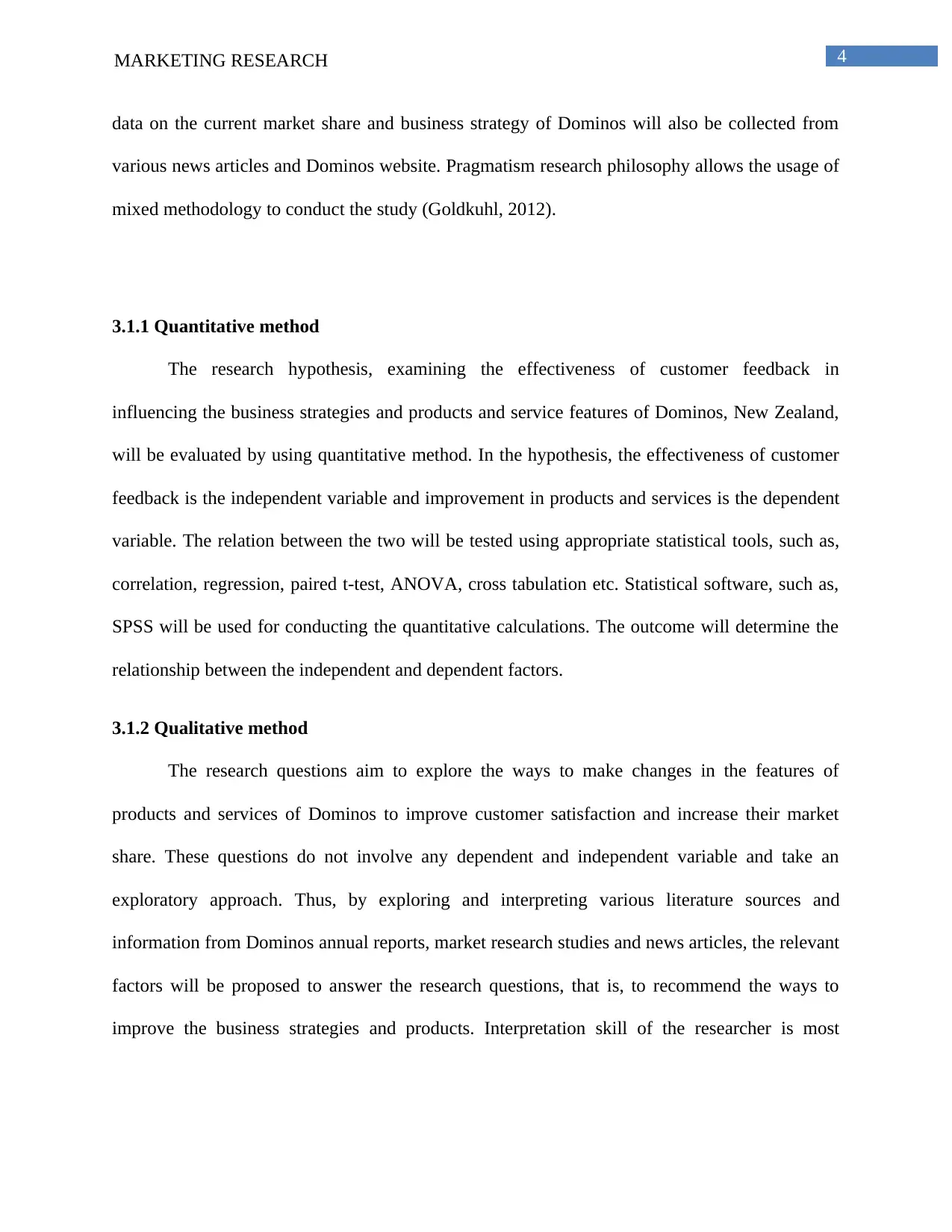
4MARKETING RESEARCH
data on the current market share and business strategy of Dominos will also be collected from
various news articles and Dominos website. Pragmatism research philosophy allows the usage of
mixed methodology to conduct the study (Goldkuhl, 2012).
3.1.1 Quantitative method
The research hypothesis, examining the effectiveness of customer feedback in
influencing the business strategies and products and service features of Dominos, New Zealand,
will be evaluated by using quantitative method. In the hypothesis, the effectiveness of customer
feedback is the independent variable and improvement in products and services is the dependent
variable. The relation between the two will be tested using appropriate statistical tools, such as,
correlation, regression, paired t-test, ANOVA, cross tabulation etc. Statistical software, such as,
SPSS will be used for conducting the quantitative calculations. The outcome will determine the
relationship between the independent and dependent factors.
3.1.2 Qualitative method
The research questions aim to explore the ways to make changes in the features of
products and services of Dominos to improve customer satisfaction and increase their market
share. These questions do not involve any dependent and independent variable and take an
exploratory approach. Thus, by exploring and interpreting various literature sources and
information from Dominos annual reports, market research studies and news articles, the relevant
factors will be proposed to answer the research questions, that is, to recommend the ways to
improve the business strategies and products. Interpretation skill of the researcher is most
data on the current market share and business strategy of Dominos will also be collected from
various news articles and Dominos website. Pragmatism research philosophy allows the usage of
mixed methodology to conduct the study (Goldkuhl, 2012).
3.1.1 Quantitative method
The research hypothesis, examining the effectiveness of customer feedback in
influencing the business strategies and products and service features of Dominos, New Zealand,
will be evaluated by using quantitative method. In the hypothesis, the effectiveness of customer
feedback is the independent variable and improvement in products and services is the dependent
variable. The relation between the two will be tested using appropriate statistical tools, such as,
correlation, regression, paired t-test, ANOVA, cross tabulation etc. Statistical software, such as,
SPSS will be used for conducting the quantitative calculations. The outcome will determine the
relationship between the independent and dependent factors.
3.1.2 Qualitative method
The research questions aim to explore the ways to make changes in the features of
products and services of Dominos to improve customer satisfaction and increase their market
share. These questions do not involve any dependent and independent variable and take an
exploratory approach. Thus, by exploring and interpreting various literature sources and
information from Dominos annual reports, market research studies and news articles, the relevant
factors will be proposed to answer the research questions, that is, to recommend the ways to
improve the business strategies and products. Interpretation skill of the researcher is most
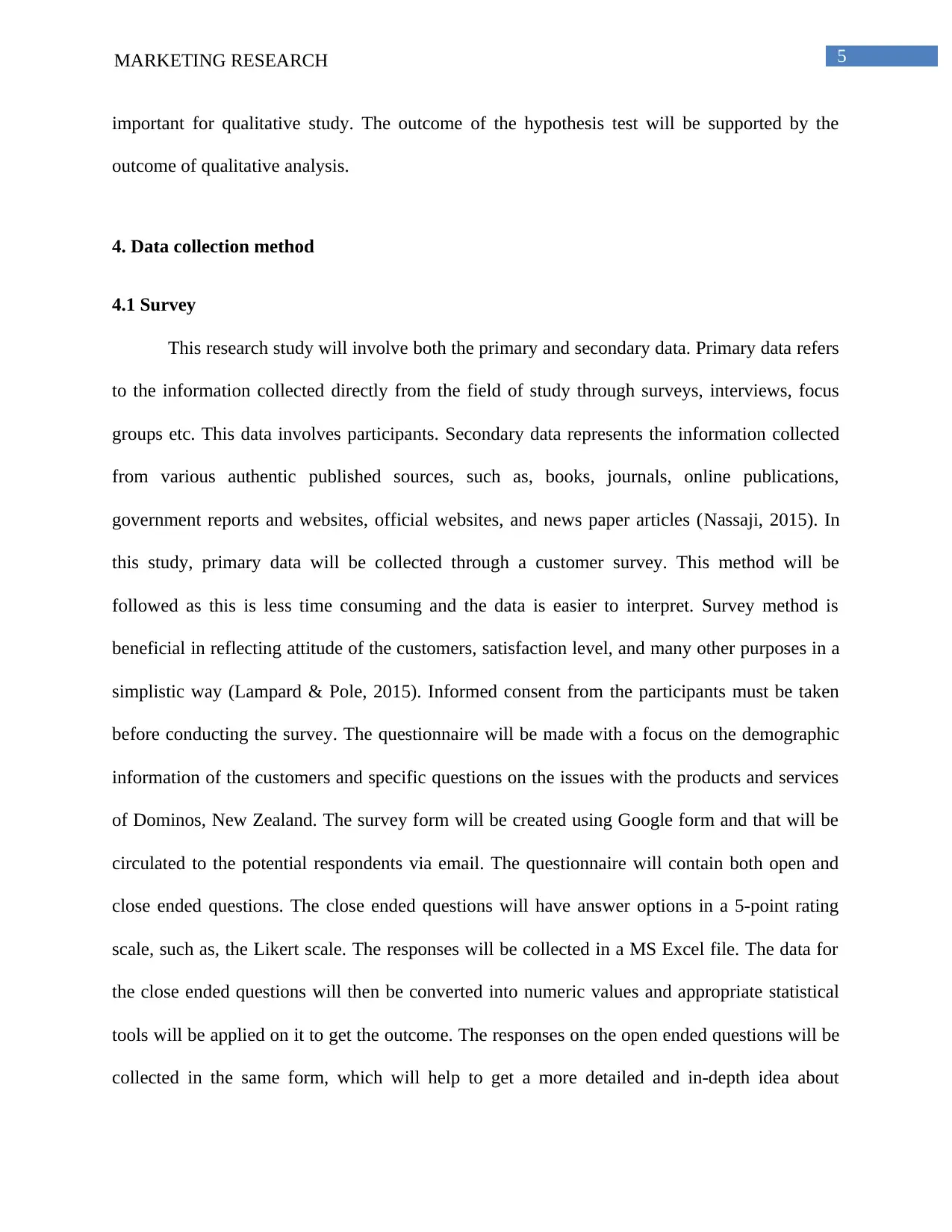
5MARKETING RESEARCH
important for qualitative study. The outcome of the hypothesis test will be supported by the
outcome of qualitative analysis.
4. Data collection method
4.1 Survey
This research study will involve both the primary and secondary data. Primary data refers
to the information collected directly from the field of study through surveys, interviews, focus
groups etc. This data involves participants. Secondary data represents the information collected
from various authentic published sources, such as, books, journals, online publications,
government reports and websites, official websites, and news paper articles (Nassaji, 2015). In
this study, primary data will be collected through a customer survey. This method will be
followed as this is less time consuming and the data is easier to interpret. Survey method is
beneficial in reflecting attitude of the customers, satisfaction level, and many other purposes in a
simplistic way (Lampard & Pole, 2015). Informed consent from the participants must be taken
before conducting the survey. The questionnaire will be made with a focus on the demographic
information of the customers and specific questions on the issues with the products and services
of Dominos, New Zealand. The survey form will be created using Google form and that will be
circulated to the potential respondents via email. The questionnaire will contain both open and
close ended questions. The close ended questions will have answer options in a 5-point rating
scale, such as, the Likert scale. The responses will be collected in a MS Excel file. The data for
the close ended questions will then be converted into numeric values and appropriate statistical
tools will be applied on it to get the outcome. The responses on the open ended questions will be
collected in the same form, which will help to get a more detailed and in-depth idea about
important for qualitative study. The outcome of the hypothesis test will be supported by the
outcome of qualitative analysis.
4. Data collection method
4.1 Survey
This research study will involve both the primary and secondary data. Primary data refers
to the information collected directly from the field of study through surveys, interviews, focus
groups etc. This data involves participants. Secondary data represents the information collected
from various authentic published sources, such as, books, journals, online publications,
government reports and websites, official websites, and news paper articles (Nassaji, 2015). In
this study, primary data will be collected through a customer survey. This method will be
followed as this is less time consuming and the data is easier to interpret. Survey method is
beneficial in reflecting attitude of the customers, satisfaction level, and many other purposes in a
simplistic way (Lampard & Pole, 2015). Informed consent from the participants must be taken
before conducting the survey. The questionnaire will be made with a focus on the demographic
information of the customers and specific questions on the issues with the products and services
of Dominos, New Zealand. The survey form will be created using Google form and that will be
circulated to the potential respondents via email. The questionnaire will contain both open and
close ended questions. The close ended questions will have answer options in a 5-point rating
scale, such as, the Likert scale. The responses will be collected in a MS Excel file. The data for
the close ended questions will then be converted into numeric values and appropriate statistical
tools will be applied on it to get the outcome. The responses on the open ended questions will be
collected in the same form, which will help to get a more detailed and in-depth idea about
⊘ This is a preview!⊘
Do you want full access?
Subscribe today to unlock all pages.

Trusted by 1+ million students worldwide
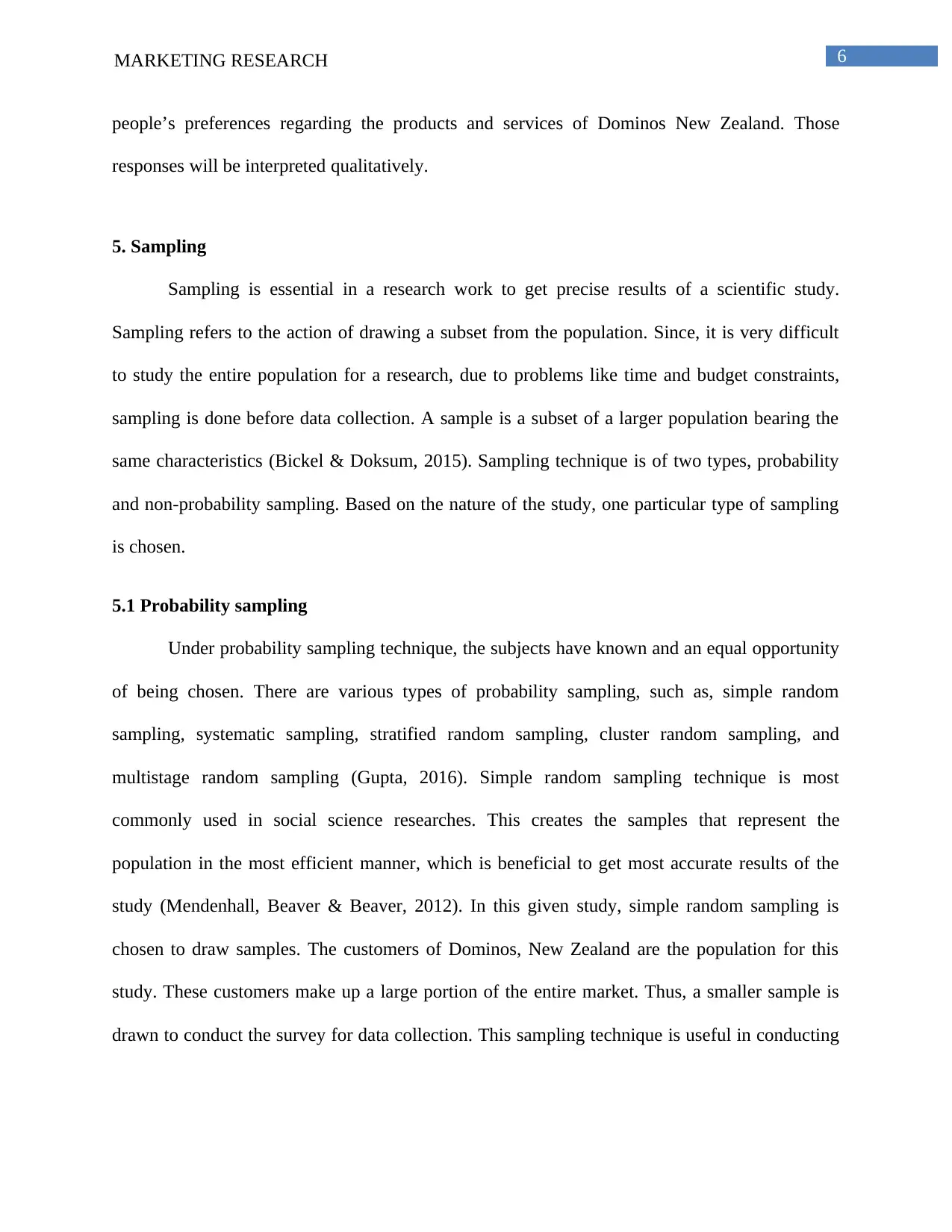
6MARKETING RESEARCH
people’s preferences regarding the products and services of Dominos New Zealand. Those
responses will be interpreted qualitatively.
5. Sampling
Sampling is essential in a research work to get precise results of a scientific study.
Sampling refers to the action of drawing a subset from the population. Since, it is very difficult
to study the entire population for a research, due to problems like time and budget constraints,
sampling is done before data collection. A sample is a subset of a larger population bearing the
same characteristics (Bickel & Doksum, 2015). Sampling technique is of two types, probability
and non-probability sampling. Based on the nature of the study, one particular type of sampling
is chosen.
5.1 Probability sampling
Under probability sampling technique, the subjects have known and an equal opportunity
of being chosen. There are various types of probability sampling, such as, simple random
sampling, systematic sampling, stratified random sampling, cluster random sampling, and
multistage random sampling (Gupta, 2016). Simple random sampling technique is most
commonly used in social science researches. This creates the samples that represent the
population in the most efficient manner, which is beneficial to get most accurate results of the
study (Mendenhall, Beaver & Beaver, 2012). In this given study, simple random sampling is
chosen to draw samples. The customers of Dominos, New Zealand are the population for this
study. These customers make up a large portion of the entire market. Thus, a smaller sample is
drawn to conduct the survey for data collection. This sampling technique is useful in conducting
people’s preferences regarding the products and services of Dominos New Zealand. Those
responses will be interpreted qualitatively.
5. Sampling
Sampling is essential in a research work to get precise results of a scientific study.
Sampling refers to the action of drawing a subset from the population. Since, it is very difficult
to study the entire population for a research, due to problems like time and budget constraints,
sampling is done before data collection. A sample is a subset of a larger population bearing the
same characteristics (Bickel & Doksum, 2015). Sampling technique is of two types, probability
and non-probability sampling. Based on the nature of the study, one particular type of sampling
is chosen.
5.1 Probability sampling
Under probability sampling technique, the subjects have known and an equal opportunity
of being chosen. There are various types of probability sampling, such as, simple random
sampling, systematic sampling, stratified random sampling, cluster random sampling, and
multistage random sampling (Gupta, 2016). Simple random sampling technique is most
commonly used in social science researches. This creates the samples that represent the
population in the most efficient manner, which is beneficial to get most accurate results of the
study (Mendenhall, Beaver & Beaver, 2012). In this given study, simple random sampling is
chosen to draw samples. The customers of Dominos, New Zealand are the population for this
study. These customers make up a large portion of the entire market. Thus, a smaller sample is
drawn to conduct the survey for data collection. This sampling technique is useful in conducting
Paraphrase This Document
Need a fresh take? Get an instant paraphrase of this document with our AI Paraphraser
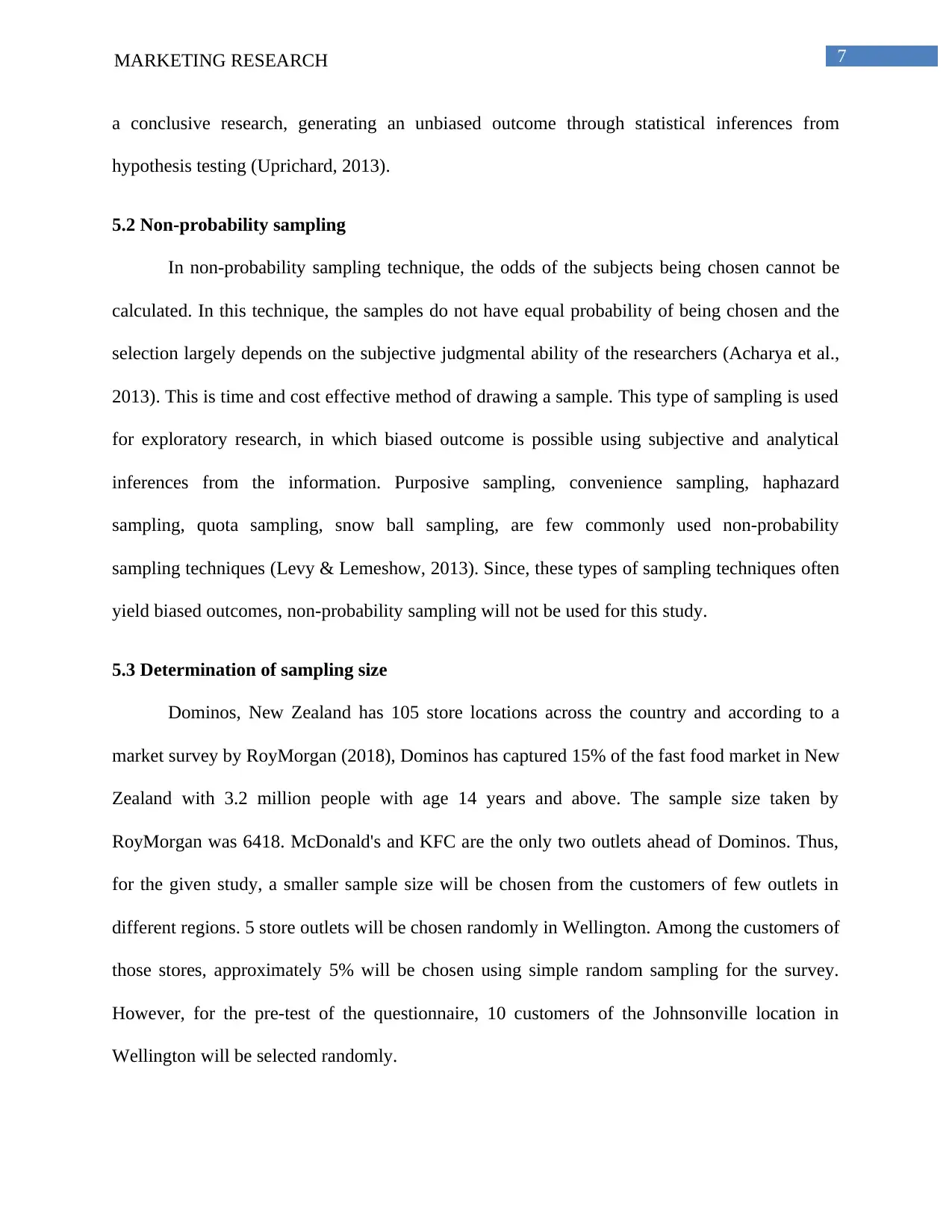
7MARKETING RESEARCH
a conclusive research, generating an unbiased outcome through statistical inferences from
hypothesis testing (Uprichard, 2013).
5.2 Non-probability sampling
In non-probability sampling technique, the odds of the subjects being chosen cannot be
calculated. In this technique, the samples do not have equal probability of being chosen and the
selection largely depends on the subjective judgmental ability of the researchers (Acharya et al.,
2013). This is time and cost effective method of drawing a sample. This type of sampling is used
for exploratory research, in which biased outcome is possible using subjective and analytical
inferences from the information. Purposive sampling, convenience sampling, haphazard
sampling, quota sampling, snow ball sampling, are few commonly used non-probability
sampling techniques (Levy & Lemeshow, 2013). Since, these types of sampling techniques often
yield biased outcomes, non-probability sampling will not be used for this study.
5.3 Determination of sampling size
Dominos, New Zealand has 105 store locations across the country and according to a
market survey by RoyMorgan (2018), Dominos has captured 15% of the fast food market in New
Zealand with 3.2 million people with age 14 years and above. The sample size taken by
RoyMorgan was 6418. McDonald's and KFC are the only two outlets ahead of Dominos. Thus,
for the given study, a smaller sample size will be chosen from the customers of few outlets in
different regions. 5 store outlets will be chosen randomly in Wellington. Among the customers of
those stores, approximately 5% will be chosen using simple random sampling for the survey.
However, for the pre-test of the questionnaire, 10 customers of the Johnsonville location in
Wellington will be selected randomly.
a conclusive research, generating an unbiased outcome through statistical inferences from
hypothesis testing (Uprichard, 2013).
5.2 Non-probability sampling
In non-probability sampling technique, the odds of the subjects being chosen cannot be
calculated. In this technique, the samples do not have equal probability of being chosen and the
selection largely depends on the subjective judgmental ability of the researchers (Acharya et al.,
2013). This is time and cost effective method of drawing a sample. This type of sampling is used
for exploratory research, in which biased outcome is possible using subjective and analytical
inferences from the information. Purposive sampling, convenience sampling, haphazard
sampling, quota sampling, snow ball sampling, are few commonly used non-probability
sampling techniques (Levy & Lemeshow, 2013). Since, these types of sampling techniques often
yield biased outcomes, non-probability sampling will not be used for this study.
5.3 Determination of sampling size
Dominos, New Zealand has 105 store locations across the country and according to a
market survey by RoyMorgan (2018), Dominos has captured 15% of the fast food market in New
Zealand with 3.2 million people with age 14 years and above. The sample size taken by
RoyMorgan was 6418. McDonald's and KFC are the only two outlets ahead of Dominos. Thus,
for the given study, a smaller sample size will be chosen from the customers of few outlets in
different regions. 5 store outlets will be chosen randomly in Wellington. Among the customers of
those stores, approximately 5% will be chosen using simple random sampling for the survey.
However, for the pre-test of the questionnaire, 10 customers of the Johnsonville location in
Wellington will be selected randomly.
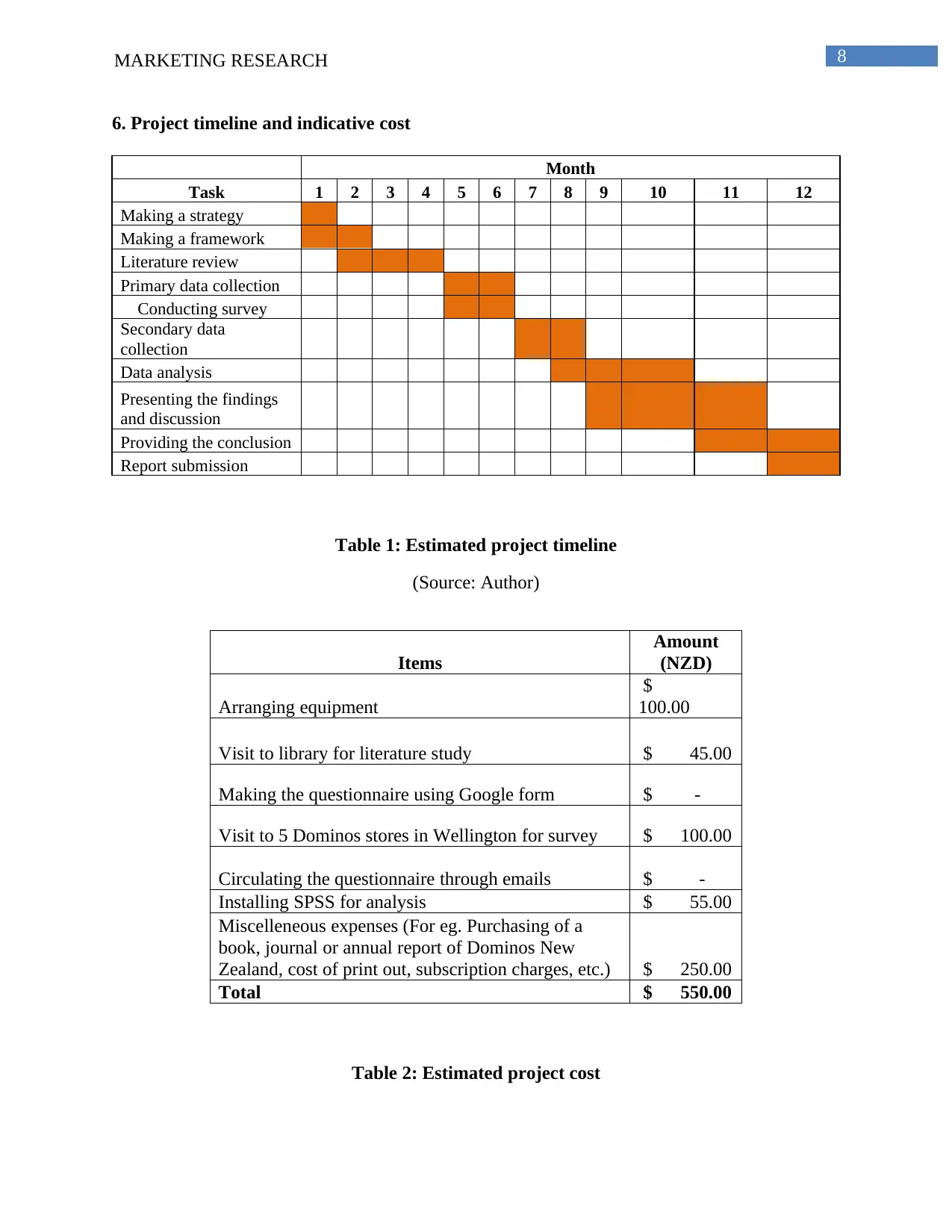
8MARKETING RESEARCH
6. Project timeline and indicative cost
Month
Task 1 2 3 4 5 6 7 8 9 10 11 12
Making a strategy
Making a framework
Literature review
Primary data collection
Conducting survey
Secondary data
collection
Data analysis
Presenting the findings
and discussion
Providing the conclusion
Report submission
Table 1: Estimated project timeline
(Source: Author)
Items
Amount
(NZD)
Arranging equipment
$
100.00
Visit to library for literature study $ 45.00
Making the questionnaire using Google form $ -
Visit to 5 Dominos stores in Wellington for survey $ 100.00
Circulating the questionnaire through emails $ -
Installing SPSS for analysis $ 55.00
Miscelleneous expenses (For eg. Purchasing of a
book, journal or annual report of Dominos New
Zealand, cost of print out, subscription charges, etc.) $ 250.00
Total $ 550.00
Table 2: Estimated project cost
6. Project timeline and indicative cost
Month
Task 1 2 3 4 5 6 7 8 9 10 11 12
Making a strategy
Making a framework
Literature review
Primary data collection
Conducting survey
Secondary data
collection
Data analysis
Presenting the findings
and discussion
Providing the conclusion
Report submission
Table 1: Estimated project timeline
(Source: Author)
Items
Amount
(NZD)
Arranging equipment
$
100.00
Visit to library for literature study $ 45.00
Making the questionnaire using Google form $ -
Visit to 5 Dominos stores in Wellington for survey $ 100.00
Circulating the questionnaire through emails $ -
Installing SPSS for analysis $ 55.00
Miscelleneous expenses (For eg. Purchasing of a
book, journal or annual report of Dominos New
Zealand, cost of print out, subscription charges, etc.) $ 250.00
Total $ 550.00
Table 2: Estimated project cost
⊘ This is a preview!⊘
Do you want full access?
Subscribe today to unlock all pages.

Trusted by 1+ million students worldwide
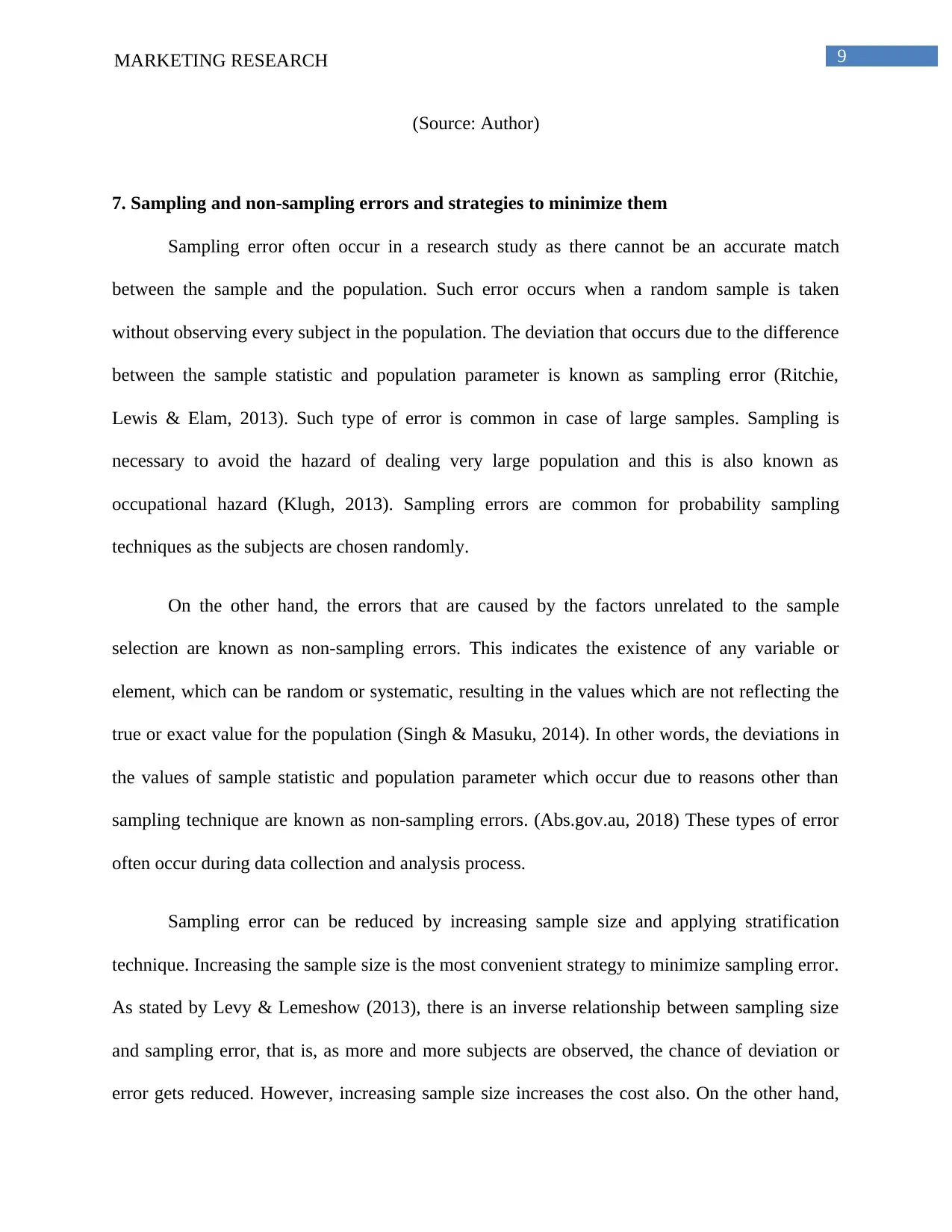
9MARKETING RESEARCH
(Source: Author)
7. Sampling and non-sampling errors and strategies to minimize them
Sampling error often occur in a research study as there cannot be an accurate match
between the sample and the population. Such error occurs when a random sample is taken
without observing every subject in the population. The deviation that occurs due to the difference
between the sample statistic and population parameter is known as sampling error (Ritchie,
Lewis & Elam, 2013). Such type of error is common in case of large samples. Sampling is
necessary to avoid the hazard of dealing very large population and this is also known as
occupational hazard (Klugh, 2013). Sampling errors are common for probability sampling
techniques as the subjects are chosen randomly.
On the other hand, the errors that are caused by the factors unrelated to the sample
selection are known as non-sampling errors. This indicates the existence of any variable or
element, which can be random or systematic, resulting in the values which are not reflecting the
true or exact value for the population (Singh & Masuku, 2014). In other words, the deviations in
the values of sample statistic and population parameter which occur due to reasons other than
sampling technique are known as non-sampling errors. (Abs.gov.au, 2018) These types of error
often occur during data collection and analysis process.
Sampling error can be reduced by increasing sample size and applying stratification
technique. Increasing the sample size is the most convenient strategy to minimize sampling error.
As stated by Levy & Lemeshow (2013), there is an inverse relationship between sampling size
and sampling error, that is, as more and more subjects are observed, the chance of deviation or
error gets reduced. However, increasing sample size increases the cost also. On the other hand,
(Source: Author)
7. Sampling and non-sampling errors and strategies to minimize them
Sampling error often occur in a research study as there cannot be an accurate match
between the sample and the population. Such error occurs when a random sample is taken
without observing every subject in the population. The deviation that occurs due to the difference
between the sample statistic and population parameter is known as sampling error (Ritchie,
Lewis & Elam, 2013). Such type of error is common in case of large samples. Sampling is
necessary to avoid the hazard of dealing very large population and this is also known as
occupational hazard (Klugh, 2013). Sampling errors are common for probability sampling
techniques as the subjects are chosen randomly.
On the other hand, the errors that are caused by the factors unrelated to the sample
selection are known as non-sampling errors. This indicates the existence of any variable or
element, which can be random or systematic, resulting in the values which are not reflecting the
true or exact value for the population (Singh & Masuku, 2014). In other words, the deviations in
the values of sample statistic and population parameter which occur due to reasons other than
sampling technique are known as non-sampling errors. (Abs.gov.au, 2018) These types of error
often occur during data collection and analysis process.
Sampling error can be reduced by increasing sample size and applying stratification
technique. Increasing the sample size is the most convenient strategy to minimize sampling error.
As stated by Levy & Lemeshow (2013), there is an inverse relationship between sampling size
and sampling error, that is, as more and more subjects are observed, the chance of deviation or
error gets reduced. However, increasing sample size increases the cost also. On the other hand,
Paraphrase This Document
Need a fresh take? Get an instant paraphrase of this document with our AI Paraphraser
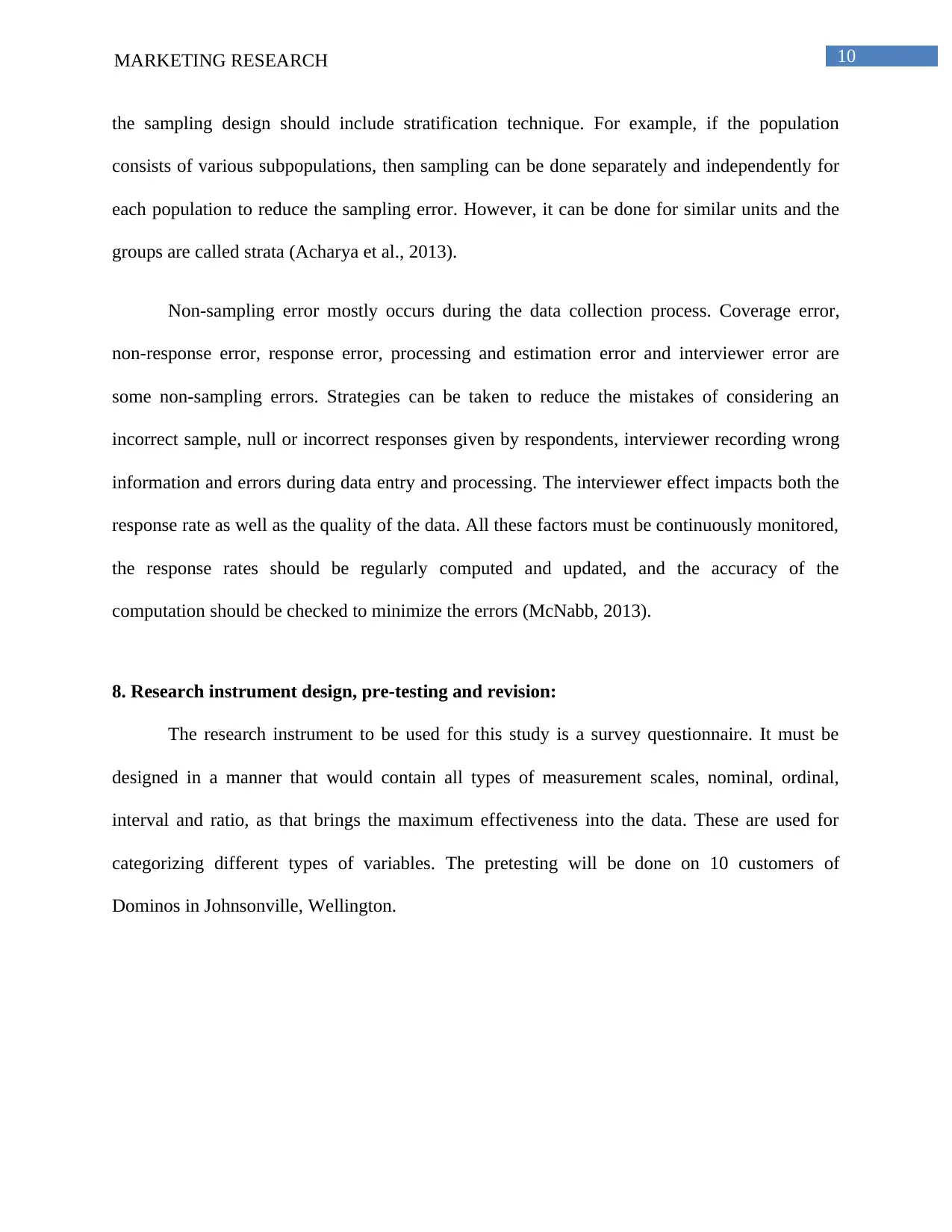
10MARKETING RESEARCH
the sampling design should include stratification technique. For example, if the population
consists of various subpopulations, then sampling can be done separately and independently for
each population to reduce the sampling error. However, it can be done for similar units and the
groups are called strata (Acharya et al., 2013).
Non-sampling error mostly occurs during the data collection process. Coverage error,
non-response error, response error, processing and estimation error and interviewer error are
some non-sampling errors. Strategies can be taken to reduce the mistakes of considering an
incorrect sample, null or incorrect responses given by respondents, interviewer recording wrong
information and errors during data entry and processing. The interviewer effect impacts both the
response rate as well as the quality of the data. All these factors must be continuously monitored,
the response rates should be regularly computed and updated, and the accuracy of the
computation should be checked to minimize the errors (McNabb, 2013).
8. Research instrument design, pre-testing and revision:
The research instrument to be used for this study is a survey questionnaire. It must be
designed in a manner that would contain all types of measurement scales, nominal, ordinal,
interval and ratio, as that brings the maximum effectiveness into the data. These are used for
categorizing different types of variables. The pretesting will be done on 10 customers of
Dominos in Johnsonville, Wellington.
the sampling design should include stratification technique. For example, if the population
consists of various subpopulations, then sampling can be done separately and independently for
each population to reduce the sampling error. However, it can be done for similar units and the
groups are called strata (Acharya et al., 2013).
Non-sampling error mostly occurs during the data collection process. Coverage error,
non-response error, response error, processing and estimation error and interviewer error are
some non-sampling errors. Strategies can be taken to reduce the mistakes of considering an
incorrect sample, null or incorrect responses given by respondents, interviewer recording wrong
information and errors during data entry and processing. The interviewer effect impacts both the
response rate as well as the quality of the data. All these factors must be continuously monitored,
the response rates should be regularly computed and updated, and the accuracy of the
computation should be checked to minimize the errors (McNabb, 2013).
8. Research instrument design, pre-testing and revision:
The research instrument to be used for this study is a survey questionnaire. It must be
designed in a manner that would contain all types of measurement scales, nominal, ordinal,
interval and ratio, as that brings the maximum effectiveness into the data. These are used for
categorizing different types of variables. The pretesting will be done on 10 customers of
Dominos in Johnsonville, Wellington.
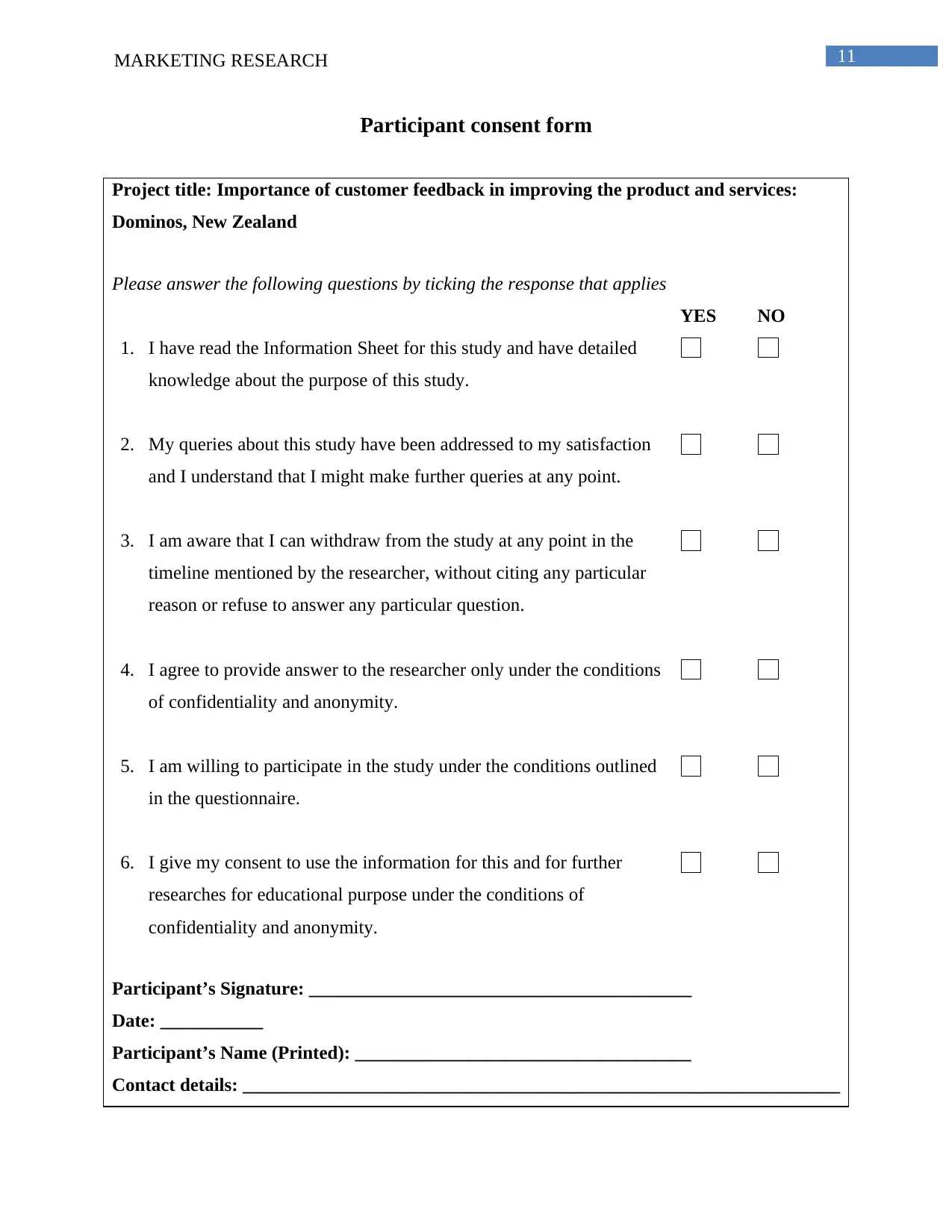
11MARKETING RESEARCH
Participant consent form
Project title: Importance of customer feedback in improving the product and services:
Dominos, New Zealand
Please answer the following questions by ticking the response that applies
YES NO
1. I have read the Information Sheet for this study and have detailed
knowledge about the purpose of this study.
2. My queries about this study have been addressed to my satisfaction
and I understand that I might make further queries at any point.
3. I am aware that I can withdraw from the study at any point in the
timeline mentioned by the researcher, without citing any particular
reason or refuse to answer any particular question.
4. I agree to provide answer to the researcher only under the conditions
of confidentiality and anonymity.
5. I am willing to participate in the study under the conditions outlined
in the questionnaire.
6. I give my consent to use the information for this and for further
researches for educational purpose under the conditions of
confidentiality and anonymity.
Participant’s Signature: _________________________________________
Date: ___________
Participant’s Name (Printed): ____________________________________
Contact details: ________________________________________________________________
Participant consent form
Project title: Importance of customer feedback in improving the product and services:
Dominos, New Zealand
Please answer the following questions by ticking the response that applies
YES NO
1. I have read the Information Sheet for this study and have detailed
knowledge about the purpose of this study.
2. My queries about this study have been addressed to my satisfaction
and I understand that I might make further queries at any point.
3. I am aware that I can withdraw from the study at any point in the
timeline mentioned by the researcher, without citing any particular
reason or refuse to answer any particular question.
4. I agree to provide answer to the researcher only under the conditions
of confidentiality and anonymity.
5. I am willing to participate in the study under the conditions outlined
in the questionnaire.
6. I give my consent to use the information for this and for further
researches for educational purpose under the conditions of
confidentiality and anonymity.
Participant’s Signature: _________________________________________
Date: ___________
Participant’s Name (Printed): ____________________________________
Contact details: ________________________________________________________________
⊘ This is a preview!⊘
Do you want full access?
Subscribe today to unlock all pages.

Trusted by 1+ million students worldwide
1 out of 22
Related Documents
Your All-in-One AI-Powered Toolkit for Academic Success.
+13062052269
info@desklib.com
Available 24*7 on WhatsApp / Email
![[object Object]](/_next/static/media/star-bottom.7253800d.svg)
Unlock your academic potential
Copyright © 2020–2025 A2Z Services. All Rights Reserved. Developed and managed by ZUCOL.





